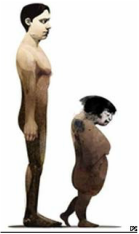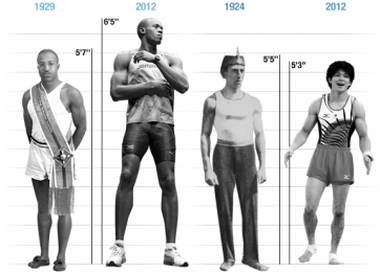|
January 3, 2023: Genetic Determinants of Aging and Longevity The contribution of genetic factors to aging is estimated at up to 30%. Recent molecular genetic methods have provided new opportunities for studying the genetic basis of human aging and longevity.
0 Comments

In the future all humans will be tall and beautiful look-alikes, as in GATTACA. Or they will split into frail beauties and sturdy beasts, as described in H. G. Wells' The Time Machine. British evolutionary psychologist Oliver Curry and paleoanthropologist Matthew Skinner believe in the possibility of similar scenarios, based on either the rich and poor divide ("gracile" vs "robust" species) or climate change-related evolution (pale hairy giants vs aquatic and space humans).
The change may be already happening, as humans continue to evolve. What traits - end products of our individual developmental histories - are most important to succeed in the modern age? 
Human history tells that individuals whose brains were better at manipulating others were more likely to survive. Additional abilities of the brain such as processing complex visual, auditory and olfactory clues have been also proven helpful and compensated for diminishing physical and sensory abilities. Invention of more sophisticated weapons, computers and sensors and the increased specialization of jobs may have slowed down the progress in some of the brain areas. Hyperspecialization would offer significant advantages for companies and society, but could it reduce humans into masters of a few simple operations? Stanford geneticist Gerald Crabtree even argues that our brains reached a peak several thousand years and have declined ever since. Not everyone agrees with this conclusion, so the jury is still out on the direction of brain evolution and the future of the intellectual elite.

The evolutionary "beauty race" is also still on. According to scientific research, humans are becoming more attractive, or at least gaining more traits preferred by other humans. It is especially pronounced in those more successful than average. American presidents, for example, are taller and healthier than other American men. French executives are 2.6 cm (1.02 inches) taller than the national average. Unattractive men in England earn 15% less than those deemed attractive, while plain women earn 11% less than pretty ones. Yet most of these traits are not exclusively determined by genes but by the access to resources and knowledge, the abilities to make the most of what you have and the confidence to carry yourself in the best way. Scientists found that height and looks during the most difficult pubescent years, influencing the development of self-confidence, are important in determining future success.

100 years ago, Olympic athletes looked pretty much like each other. Modern Olympians present vastly different versions of an athletic body, illustrating that human evolution could go many different ways. 6'5'' Usain Bolt is less aerodynamic and has far more "fast-twitch" muscle fibers than previous runners and most modern day humans. 5'3'' Kohei Uchimura has BMI of 21 and lower body fat percentage than most Olympic gymnasts of the past.
Commercially available genetic tests related to exercise and sport are widely criticized for ethical and scientific reasons, but height and the length of limbs are already used for pre-screening of children to determine which sport they might excel in. More genetic and physiological measurements will be utilized in the future. One recent discovery is the asymmetrical egg shape of the right hip joints for golfers, although it remains to be established whether professional golfers have this trait because of extensive training or whether players with such hip shapes are more likely to become professional. Like beauty and brains, bodies are shaped by both nature and nurture and might require early training and specialization. Will the future society be divided into factions with pre-determined fates? In an ever more competitive world starting to resemble Olympic games, will our genes and childhood bodies decide - once and for all - what we do for the rest of our lives?
REFERENCES
Crabtree, G. (2013). Our fragile intellect. Part II Trends in Genetics, 29 (1), 3-5 DOI: 10.1016/j.tig.2012.10.003
Williams AG, Wackerhage H, & Day SH (2016). Genetic Testing for Sports Performance, Responses to Training and Injury Risk: Practical and Ethical Considerations. Medicine and sport science, 61, 105-19 PMID: 27287080
Dickenson, E., O'Connor, P., Robinson, P., Campbell, R., Ahmed, I., Fernandez, M., Hawkes, R., Charles, H., & Griffin, D. (2016). Hip morphology in elite golfers: asymmetry between lead and trail hips British Journal of Sports Medicine, 50 (17), 1081-1086 DOI: 10.1136/bjsports-2016-096007
|
Categories
All
Environment
|


 RSS Feed
RSS Feed
